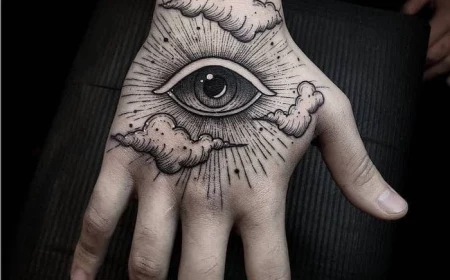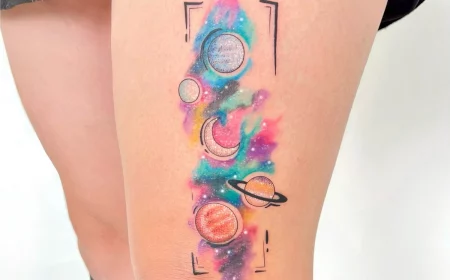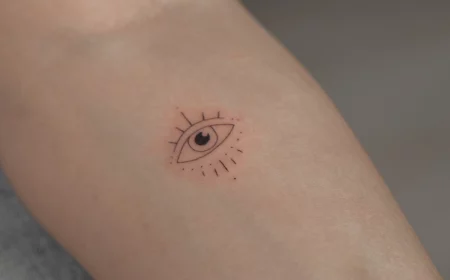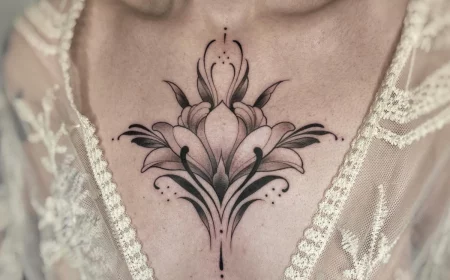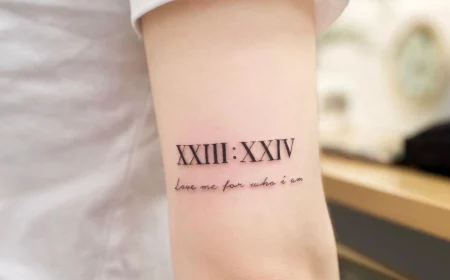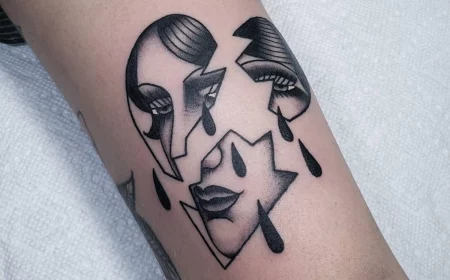Thinking About a Butterfly Tattoo? Here’s What You Actually Need to Know
As a tattoo artist, you see trends come and go, but some designs are just plain timeless. The butterfly is definitely one of them. I’ve probably tattooed hundreds over the years, from tiny, delicate whispers on a wrist to massive, full-back pieces that take days of work. It’s one of those designs that seems simple on the surface, but honestly, it’s packed with meaning.
In this article
- The Real Meaning: It’s Way More Than Just Transformation
- Let’s Talk Styles: Which One Is Right for You?
- Placement, Pain, and Price: What to Expect
- The Day Before Your Tattoo: A Quick Checklist
- Cover-Ups and Fixes: The Butterfly’s Secret Superpower
- Your Aftercare Shopping List
- Choosing Your Artist and Staying Safe
- It’s Your Story on Your Skin
- Inspirational Gallery
So many people walk in thinking a butterfly just means ‘beauty’ or ‘change.’ And sure, it does, but that’s just scratching the surface. This little insect carries a lot of symbolic weight, and for us artists, it presents a fascinating technical challenge. Getting a butterfly tattoo is about more than just picking a pretty picture off the wall; it’s about translating a personal story into a piece of art that will live on your skin forever.
Let’s get into what I’ve learned from thousands of hours in the studio—from the real symbolism to the nitty-gritty of cost, pain, and making sure you get a tattoo that you’ll love for a lifetime.
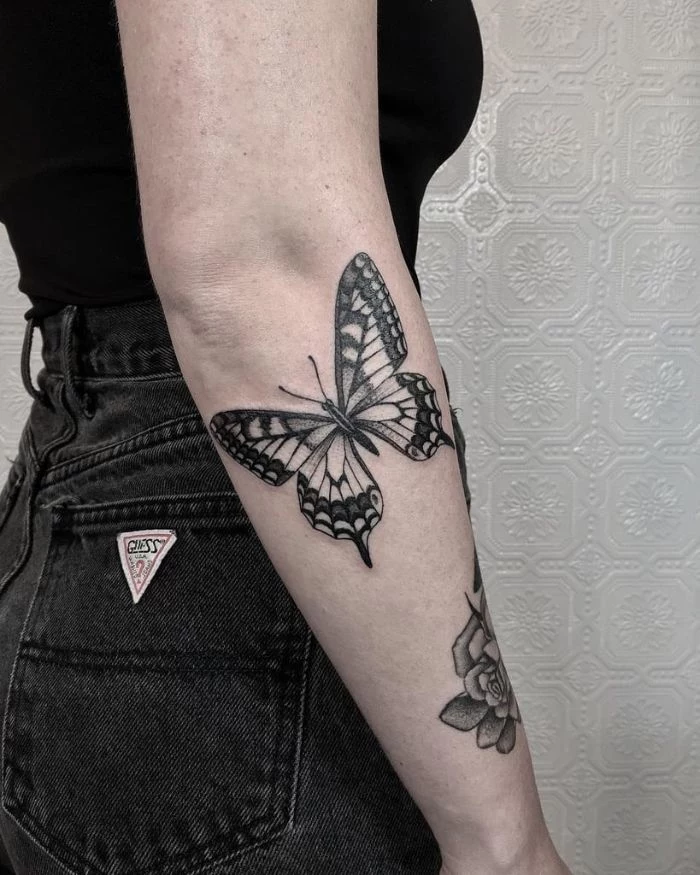
The Real Meaning: It’s Way More Than Just Transformation
Okay, so the number one reason people ask for a butterfly is transformation. It’s a powerful and obvious metaphor, right? The whole caterpillar-to-butterfly journey perfectly mirrors our own growth. I’ve worked with clients marking huge life moments—celebrating sobriety, finishing a tough degree, or finally leaving a toxic situation. The tattoo becomes this permanent badge of honor that says, “I went through something tough, and I came out stronger and more beautiful.”
One of the most memorable pieces I did was for a client who wanted a butterfly breaking out of a cracked stone chrysalis on their forearm. It was their way of marking recovery from a serious illness. The design wasn’t delicate at all; it was rugged and intense, a reminder that transformation is often a struggle, not some gentle, poetic unfolding.
But the symbolism goes even deeper:
- Spirits and Souls: In some cultures, butterflies are seen as the souls of the living or even as messengers from the spirit world. A single white butterfly can be a gentle nod to a loved one who has passed on. It’s a beautiful way to create a memorial piece that feels peaceful and free. By the way, a pair of butterflies often represents a happy partnership, making them a surprisingly cool idea for a couple’s tattoo.
- Freedom and Lightness: This one’s pretty straightforward. Butterflies fly. They represent ditching your burdens and feeling free. I once had a client who wanted to capture the feeling of quitting a soul-crushing job. We designed a little flurry of blue butterflies fluttering up her arm, like a visual sigh of relief.
- Living in the Moment: A butterfly’s life is beautiful but short. This can be a powerful reminder to appreciate the here and now. Some people even choose designs with slightly tattered or torn wings. It’s a way of showing beauty in imperfection and acknowledging that life can be tough, but we’re still flying.
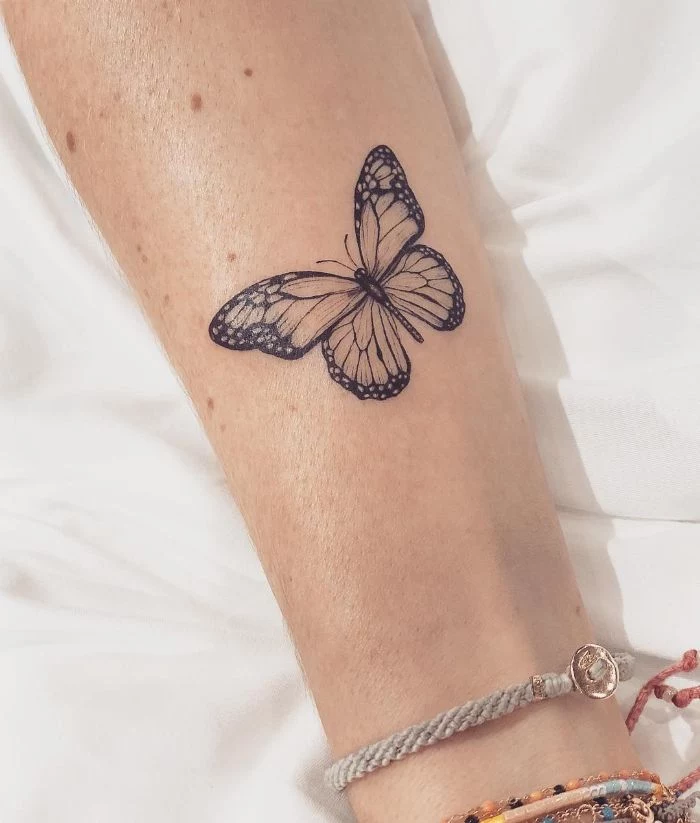
Let’s Talk Styles: Which One Is Right for You?
A butterfly can be drawn in pretty much any style, and the style you pick completely changes the vibe and, frankly, how well it will age. There’s no table or chart for this, it’s about feel and function.
If you want something that will look bold and clear for decades, American Traditional is your best bet. We’re talking thick black outlines, a limited but punchy color palette (think reds, yellows, greens), and simple shading. These things are built to last and are readable from across the room. They age like fine wine.
For a more detailed, illustrative look, you might lean towards Neo-Traditional. This style takes the solid foundation of traditional—the bold lines are still there—but adds way more detail, a broader color palette, and more complex shading. You get a more ornate, dimensional butterfly that still has amazing staying power.
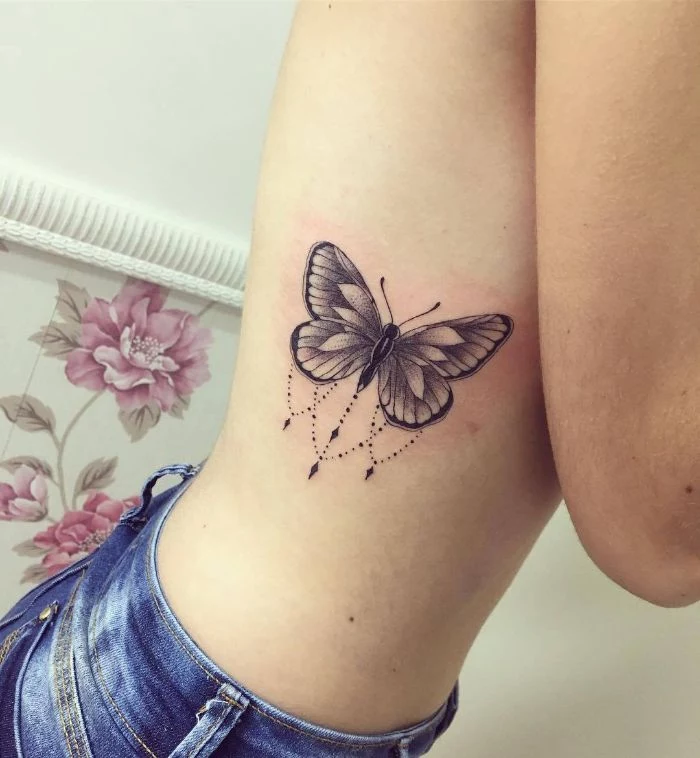
Then there’s Realism, both in black and grey or full color. This is where the artist aims to make the butterfly look like it could fly right off your skin. We use soft shading and layered colors to create depth and texture. A common trick is to add a faint drop-shadow underneath one wing, which creates a stunning 3D effect. The result is incredible, but it requires a highly skilled artist.
And what about the Watercolor style? These tattoos are beautiful, often with no black outlines and soft, blended colors that look like they were painted on. They feel light and artistic. But here’s the honest truth: because they lack those strong black outlines that act as a container, they can be more prone to fading or spreading over time. They’re gorgeous, but you should go into it expecting that you might need a touch-up in 5 to 10 years to keep the colors fresh. A good artist will be upfront about this.
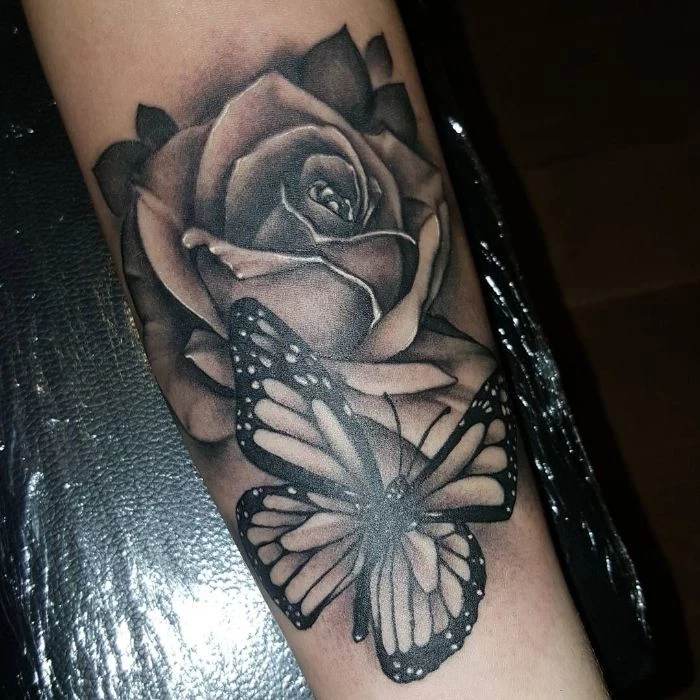
Placement, Pain, and Price: What to Expect
A great design can be let down by bad placement. The best tattoos work with the body, not against it. Butterflies are super versatile, so you’ve got options.
For a first tattoo, or if you just want something subtle, the wrist, ankle, or behind the ear are classic spots. A small, 2-inch fine-line butterfly on the inner wrist is a popular choice. Heads up, this is where you’ll start wondering about cost and time. For a piece like that, you can expect to be in the chair for about an hour, and depending on the artist’s rate and your city, the price will likely fall somewhere between $150 and $300.
Medium-sized spots like the forearm, calf, or shoulder blade are perfect for showing a bit more detail. A butterfly on a shoulder blade can look like it just landed there. For a design like this, maybe hand-sized, you’re probably looking at a 2-3 hour session and a price tag in the $300 to $600 range. For larger, more complex pieces on the thigh or back, artists often switch to an hourly rate (anywhere from $150-$250+/hour) or a day rate.

Now, about the pain. I’m not going to lie to you—it’s a needle, it’s going to hurt. But how much it hurts varies a lot. Fleshy spots like your outer thigh or forearm are generally pretty manageable. The bony areas with thin skin? That’s a different story. The ribs, spine, feet, and sternum are notoriously spicy. If you want a butterfly on your ribs, just be prepared. We’ll take breaks, and I’ll work efficiently, but you’ll need to be ready to breathe through it.
The Day Before Your Tattoo: A Quick Checklist
People always focus on aftercare, but setting yourself up for a good session starts the day before. It’s simple stuff, but it makes a HUGE difference.
- Get a good night’s sleep. Don’t show up exhausted.
- Eat a substantial meal about an hour before your appointment. Your body needs fuel to handle the process.
- Bring a sugary drink and a snack. A little sugar boost can be a lifesaver, especially during a longer session.
- Do not drink alcohol for at least 24 hours beforehand. It thins your blood, which can make you bleed more and affect how the ink settles.
- Wear comfy clothes that give easy access to the tattoo spot. You might be sitting for a while!
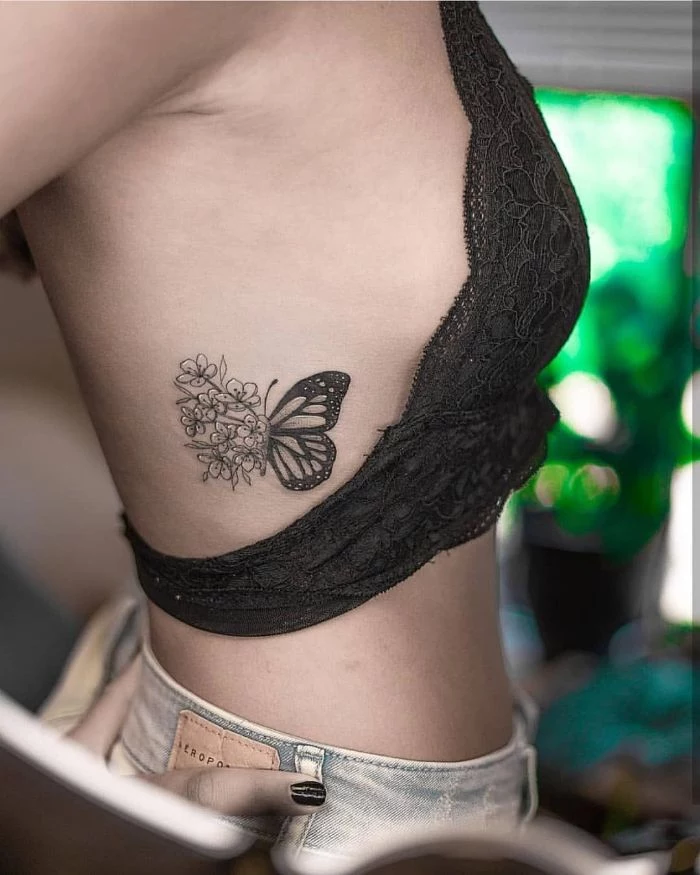
Cover-Ups and Fixes: The Butterfly’s Secret Superpower
Believe it or not, butterflies are one of an artist’s best tools for cover-ups. The intricate, dark, and asymmetrical patterns in many butterfly wings are perfect for hiding an old tattoo you’ve fallen out of love with. A lesser-known trick is to make sure the darkest parts of the new butterfly—like the body and the thick black patterns on the wings—go directly over the darkest parts of the old tattoo. A skilled artist can make an old piece completely disappear.
And sometimes, a tattoo doesn’t heal perfectly. That’s okay! Most professional artists offer a free touch-up session within the first few months. It’s part of ensuring you get a quality piece that lasts.
Your Aftercare Shopping List
Healing a tattoo is a partnership. I do my job in the studio, and then it’s your turn. Proper aftercare is non-negotiable. Here’s your simple shopping list, which should cost you less than $20 at any drugstore.

- An unscented, antibacterial soap. Dial Gold is the classic for a reason.
- A simple, fragrance-free lotion. Something like Lubriderm, Cetaphil, or Eucerin is perfect.
- (Optional) A healing ointment. For the first day or two, a very thin layer of something like Aquaphor can be great. After that, switch to lotion.
The rules are simple: for about two weeks, wash it gently, pat it dry, and apply a thin layer of lotion. No swimming, no baths (showers are fine!), no sunbathing, and absolutely no picking at it.
Long-term, the sun is your tattoo’s worst enemy. UV rays will break down the ink and turn your beautiful art into a blurry mess. If you want it to look crisp for decades, get in the habit of using a strong sunscreen (SPF 30+) on it anytime it’s exposed.
Choosing Your Artist and Staying Safe
Please, don’t shop for a tattoo based on price. Good tattoos aren’t cheap, and cheap tattoos are rarely good. Your health is on the line.
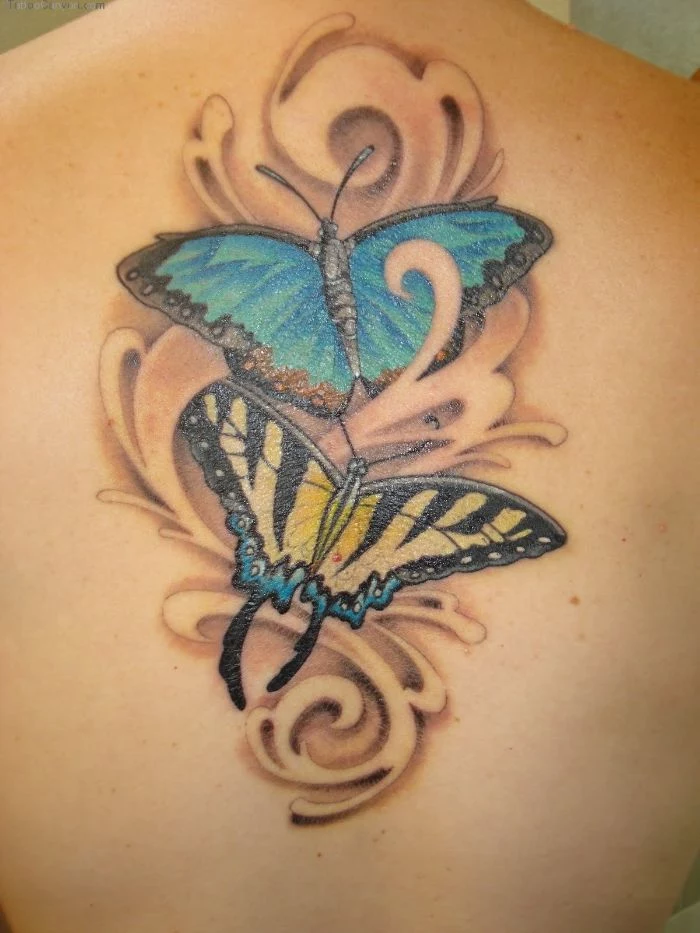
Look for an artist whose style you truly love. Go through their portfolio. Look for clean lines and smooth, saturated color. Here’s a pro tip: ALWAYS ask to see photos of healed work, not just the fresh, glossy photos they post on Instagram. A great artist is proud of how their work holds up over time, and healed photos (from at least a year ago) are the true test of skill.
Oh, and one more thing on safety. Allergic reactions to ink are rare, but they can happen, especially with reds. If you have sensitive skin or a history of allergies, ask your artist about doing a spot test. It’s simple: they can put a tiny, hidden dot of ink on your skin a week or two before the main appointment to see if you have a reaction. It’s a quick and easy way to get peace of mind.
When you walk into a studio, it should feel as clean as a doctor’s office. The artist should open new, sterile needles in front of you and wear gloves. If you get a bad vibe or it looks dirty, just walk out. Your safety is worth more than hurting someone’s feelings.
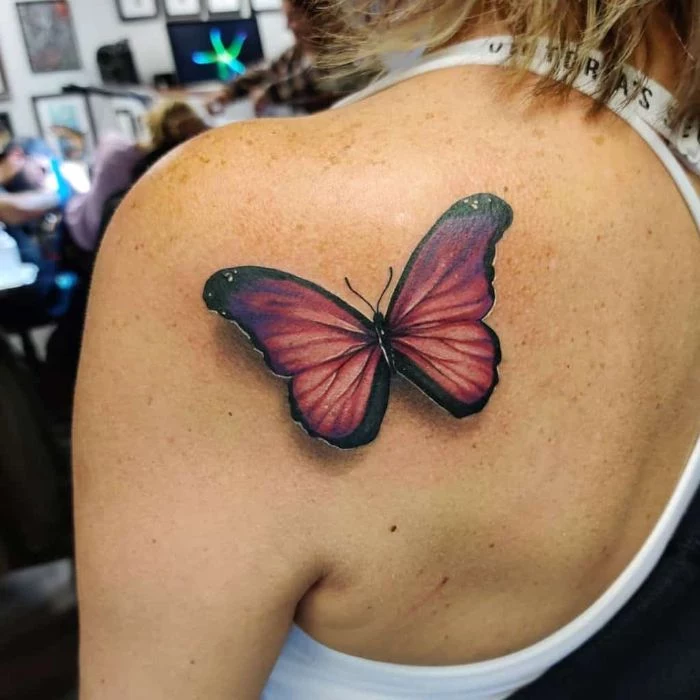
It’s Your Story on Your Skin
At the end of the day, a butterfly tattoo is so much more than a passing fad. It’s a powerful, personal symbol that can represent growth, freedom, loss, or love. It’s a true collaboration between your story and an artist’s skill. So choose your design with care, find an artist you trust, and you’ll end up with a beautiful piece of art that you’ll be proud to wear for the rest of your life.
Inspirational Gallery
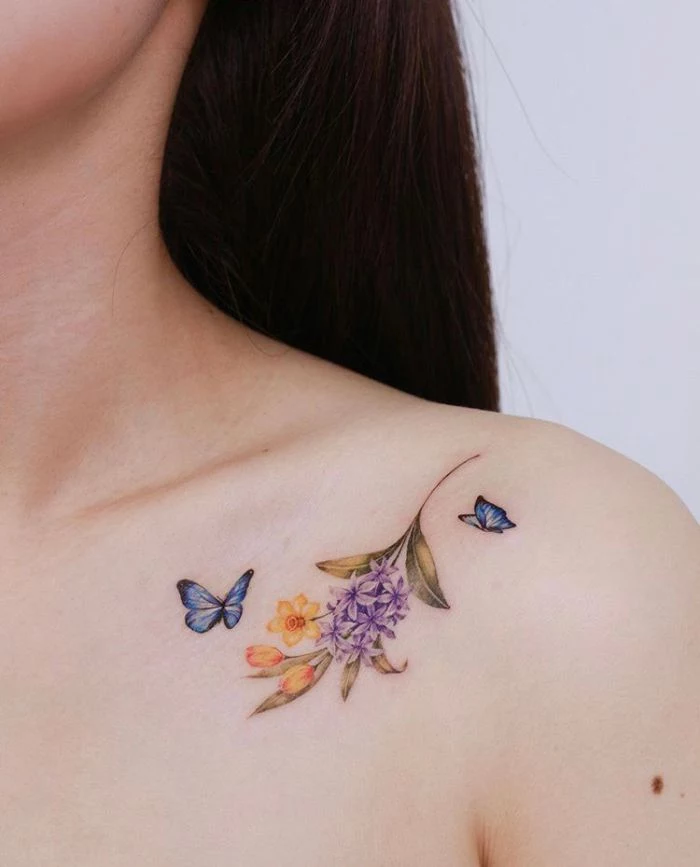
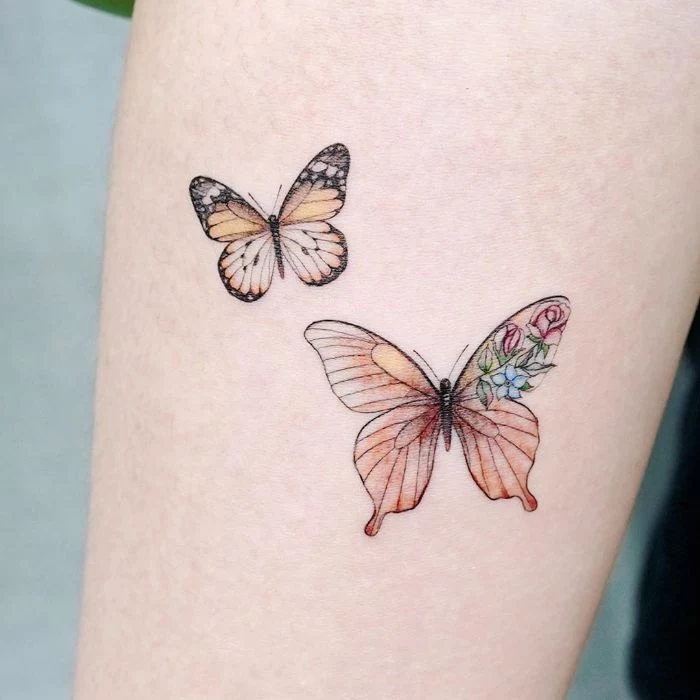
Placement is more than just aesthetics; it’s about anatomy. A butterfly tattoo will look most dynamic when its shape flows with the natural curves of your body. Consider how the wings can wrap around a shoulder, how the body can align with the length of a forearm, or how a fluttering pair can ascend the ribcage. A skilled artist will sketch the design directly onto your skin to ensure it moves with you, not just sits on you.
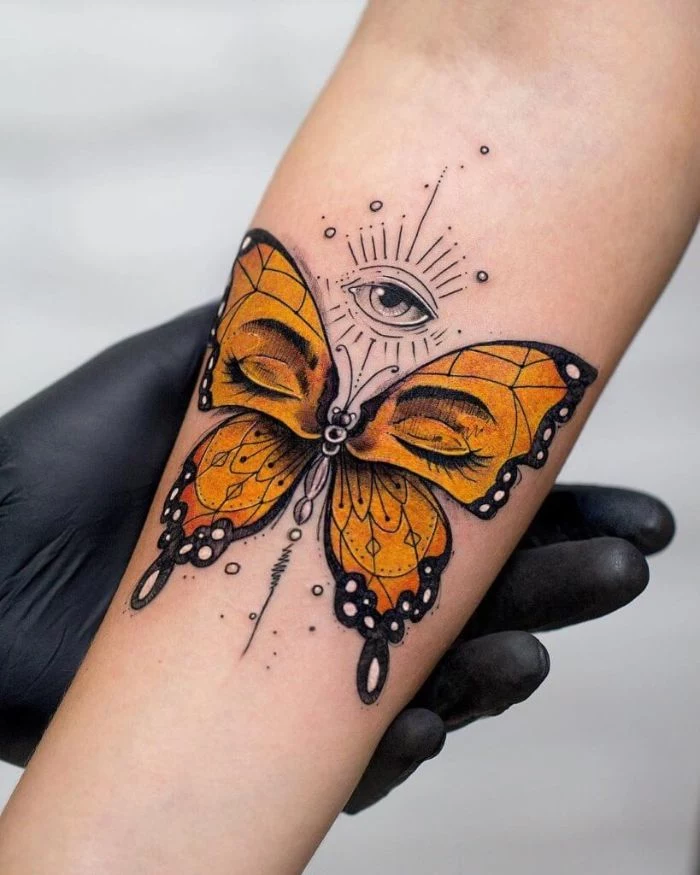
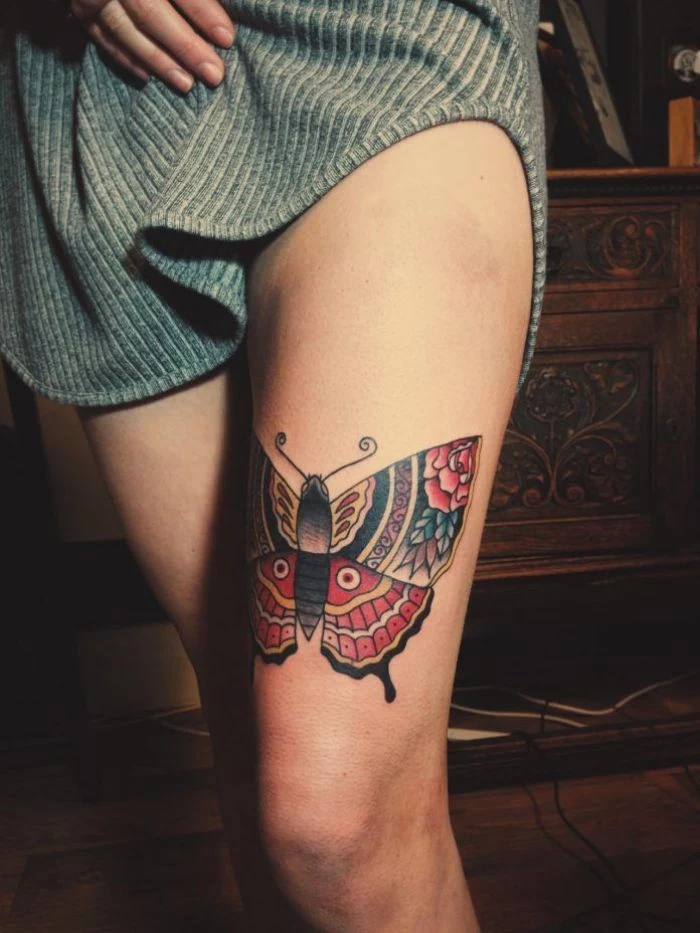
- Vibrant colors that don’t fade into a blur.
- Crisp, sharp lines that stay defined for decades.
- A design that remains a clear statement, not a muddled patch.
The secret? Don’t skimp on size. Especially for detailed or colorful butterflies, a slightly larger design gives the ink room to settle and age gracefully without the fine details bleeding into each other.
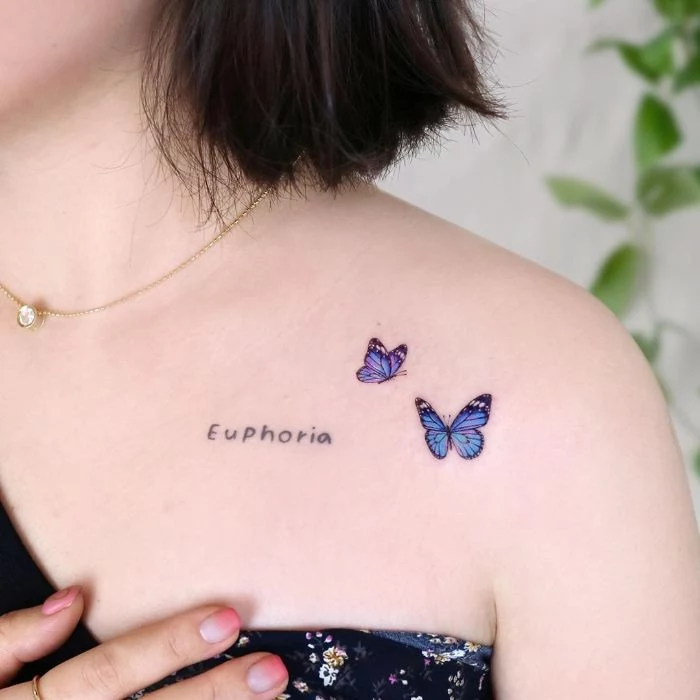
In Greek mythology, the goddess Psyche was often depicted with butterfly wings. Her name literally means ‘soul,’ ‘spirit,’ or ‘breath of life.’
This ancient connection elevates the butterfly beyond simple transformation. It ties it to the very essence of the human soul, its trials, and its ultimate triumph through love and perseverance. A butterfly tattoo can be a subtle nod to this powerful, enduring myth.
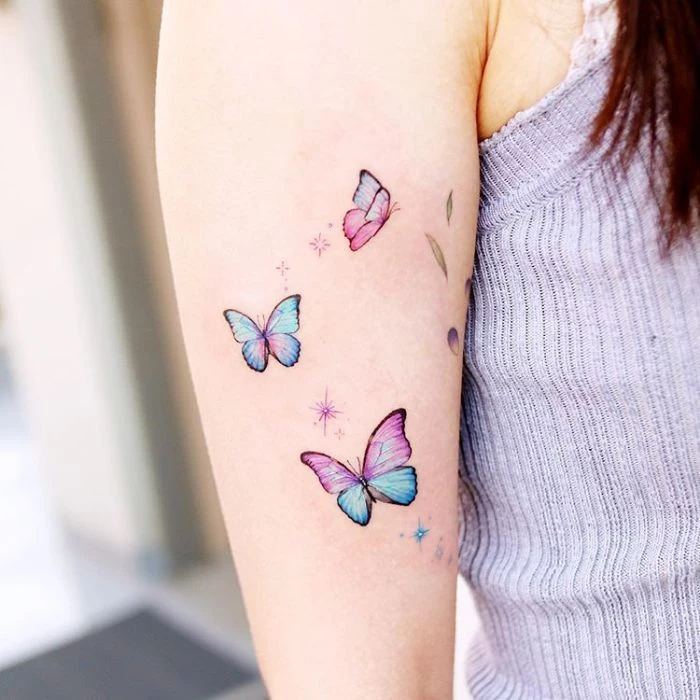
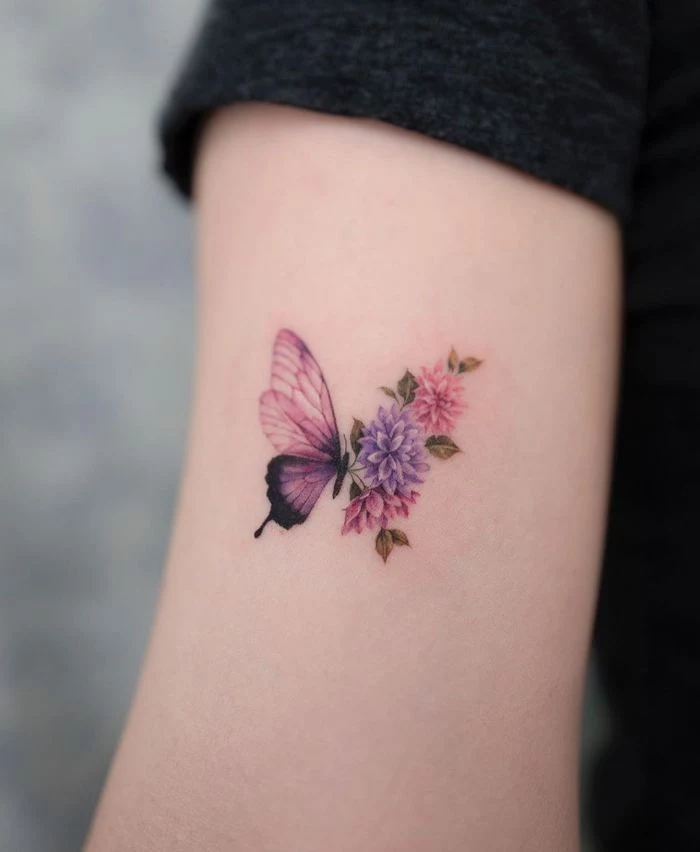
Thinking about color? Let’s talk longevity.
Yellows and whites tend to fade the fastest, especially with sun exposure, and may require more frequent touch-ups. In contrast, black, dark blues, and deep greens hold their integrity for much longer. For a vibrant piece that lasts, consider a design anchored with a strong black outline and shading, using brighter colors as highlights rather than the main fill. This technique, common in Neo-Traditional styles, ensures your butterfly stays brilliant.
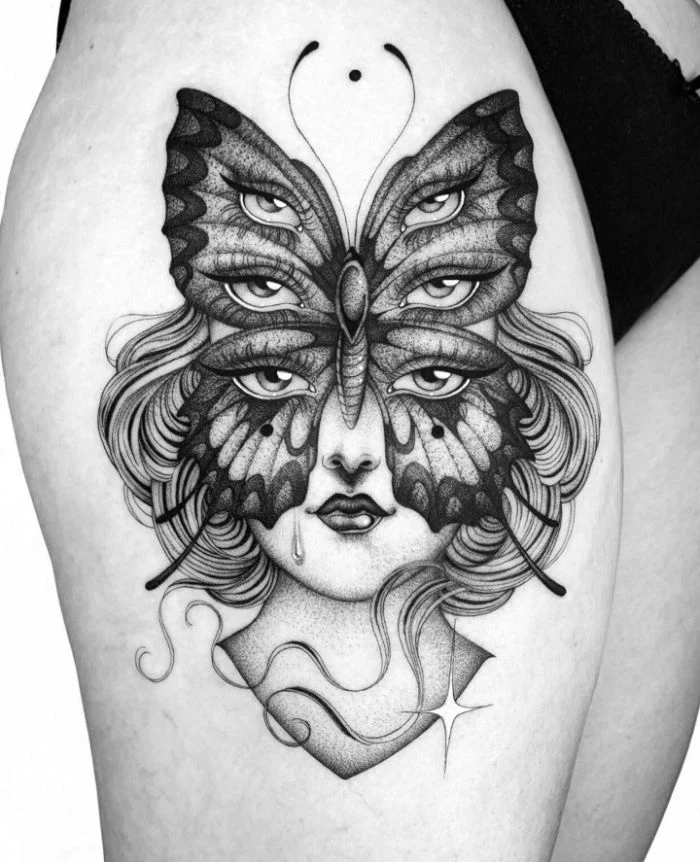
American Traditional: Bold black outlines, a limited and saturated color palette (think red, green, yellow), and iconic, timeless styling. Your butterfly will be stylized and powerful.
Watercolor: No outlines, with soft, blended colors that mimic a brushstroke effect. It’s ethereal and artistic, but be sure your artist is a specialist, as poorly done watercolor tattoos can age into indistinct blobs.
For longevity and clarity, traditional often wins, but for a delicate, modern feel, watercolor is stunning.
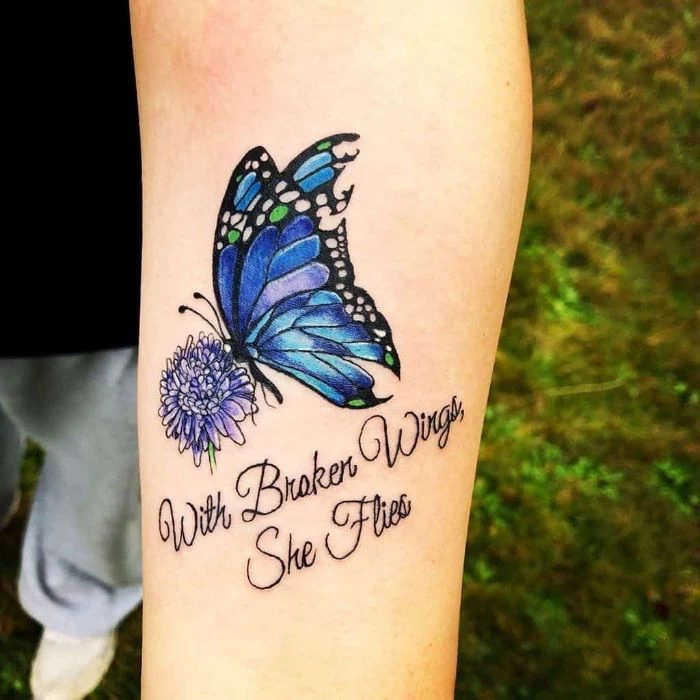
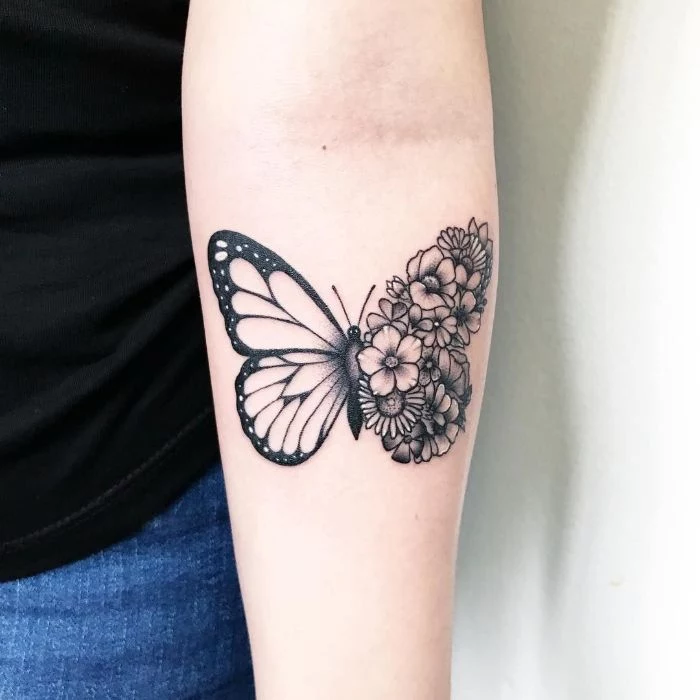
Preparing for your tattoo appointment isn’t just about being on time. The day before, focus on hydrating and avoid alcohol, as it can thin your blood and increase bleeding. Get a good night’s sleep and have a solid meal before you go in; it helps your body manage pain and endurance, especially for a longer session.
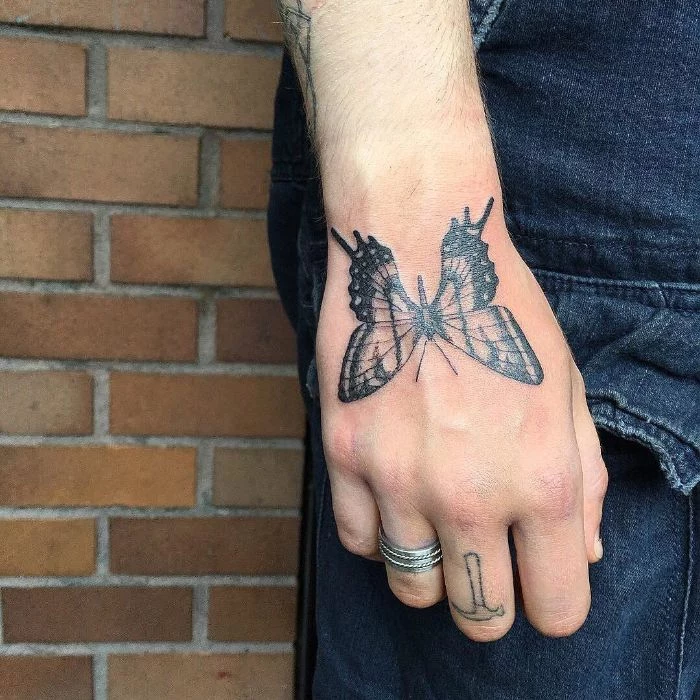
- A high-quality, broad-spectrum sunscreen with at least SPF 30.
- Apply it 15 minutes before sun exposure.
- Reapply every two hours, or more if swimming or sweating.
This isn’t just for new tattoos. Sun is the number one enemy of ink, breaking down pigments over time. Protecting your butterfly from UV rays is the single best thing you can do to keep it looking sharp and vibrant for life.
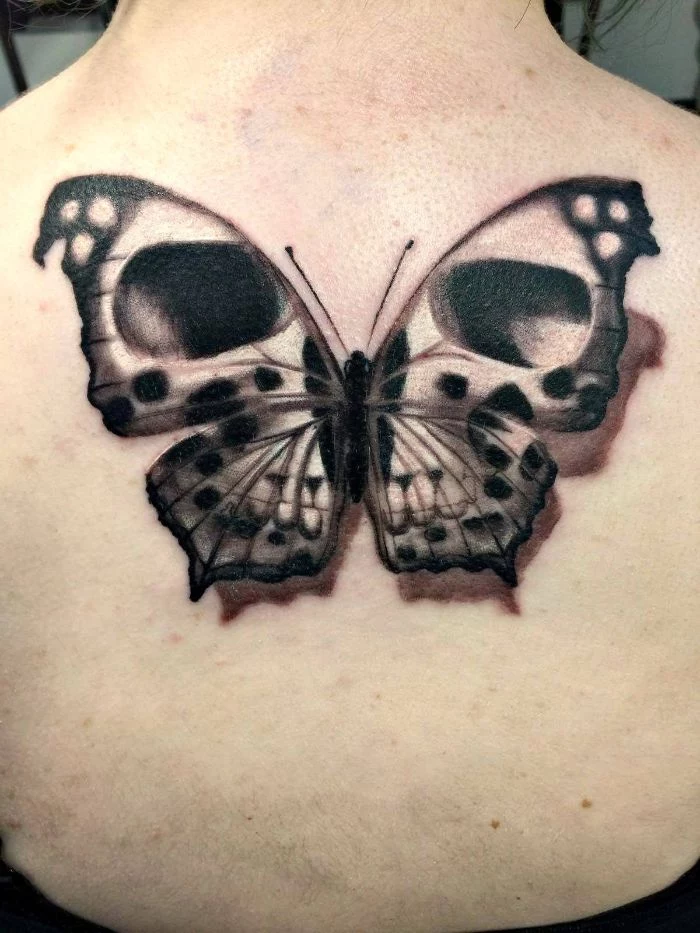
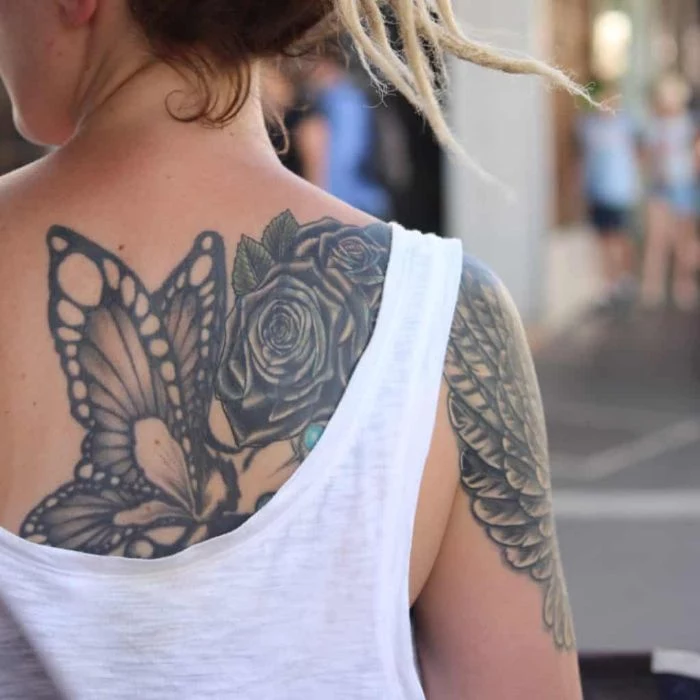
A common pitfall: Getting fixated on an exact photo from Pinterest. Remember, a design that looks great on one person’s thigh might not work on your wrist. Use images as inspiration, not as a rigid command. Trust your artist to adapt the concept to your unique body shape and skin tone for a truly custom piece that’s better than any photo.

According to a 2023 study, the global market for vegan tattoo inks is growing by over 7% annually.
What does this mean for you? It’s easier than ever to get a butterfly tattoo that aligns with your values. Brands like Eternal Ink, World Famous Ink, and Intenze offer complete lines of high-quality, cruelty-free pigments. Just ask your artist what they use; most modern studios are proud to offer vegan options.
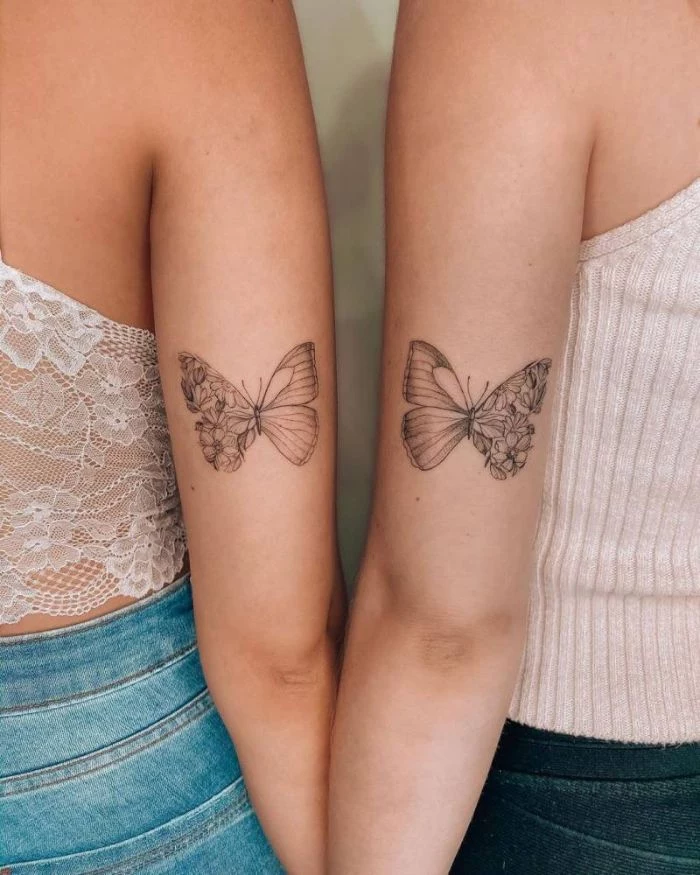
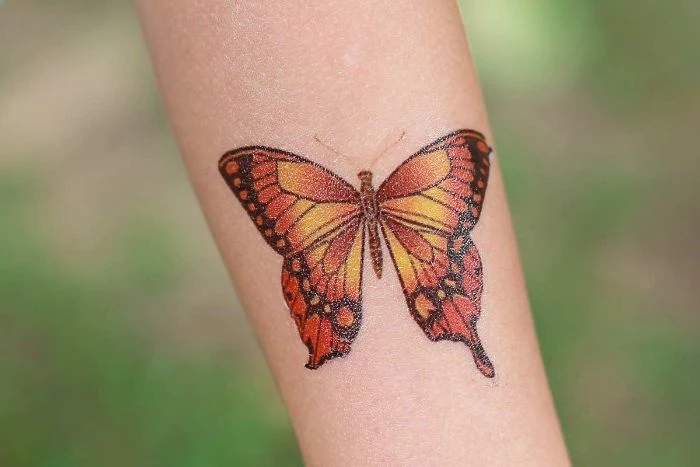
That initial wrap your artist applies is crucial. More and more studios are using transparent adhesive films like Saniderm or Dermalize. Unlike plastic wrap, this ‘second skin’ is breathable, waterproof, and can be left on for several days. It protects your fresh tattoo from bacteria while allowing it to heal in its own plasma, which often results in faster healing and more vibrant color retention.
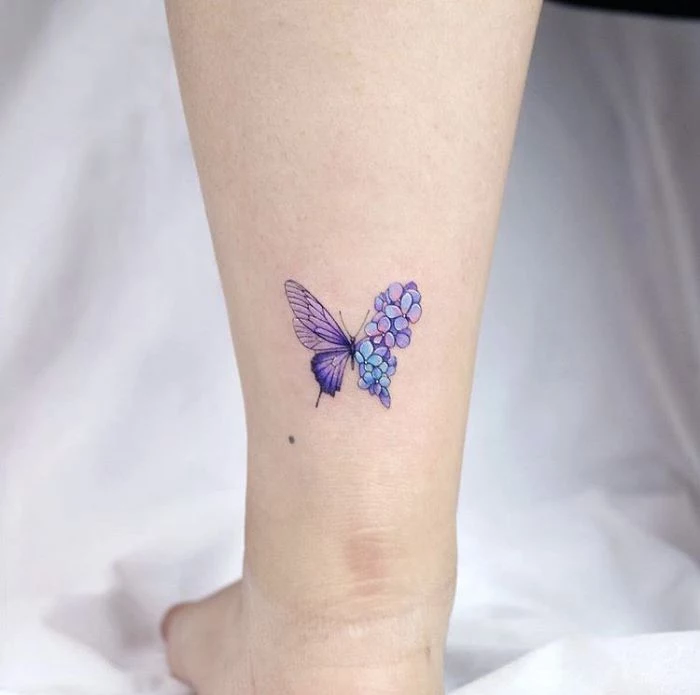
Wondering what that half-butterfly, half-flower design means?
This popular style, often seen in delicate fine-line work, is a beautiful fusion of two powerful symbols. It represents a transformation that is intrinsically linked to nature, growth, and organic beauty. It says that personal evolution is not a mechanical process, but a blossoming—one that is both delicate and resilient.
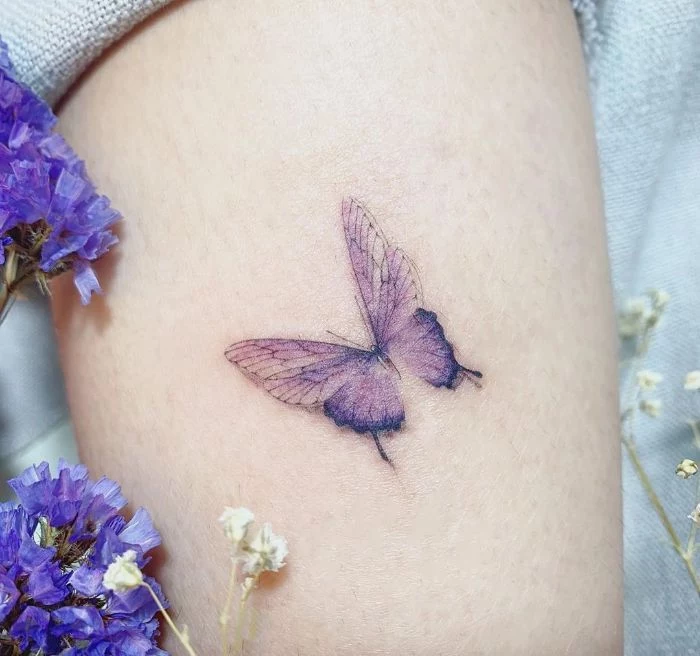
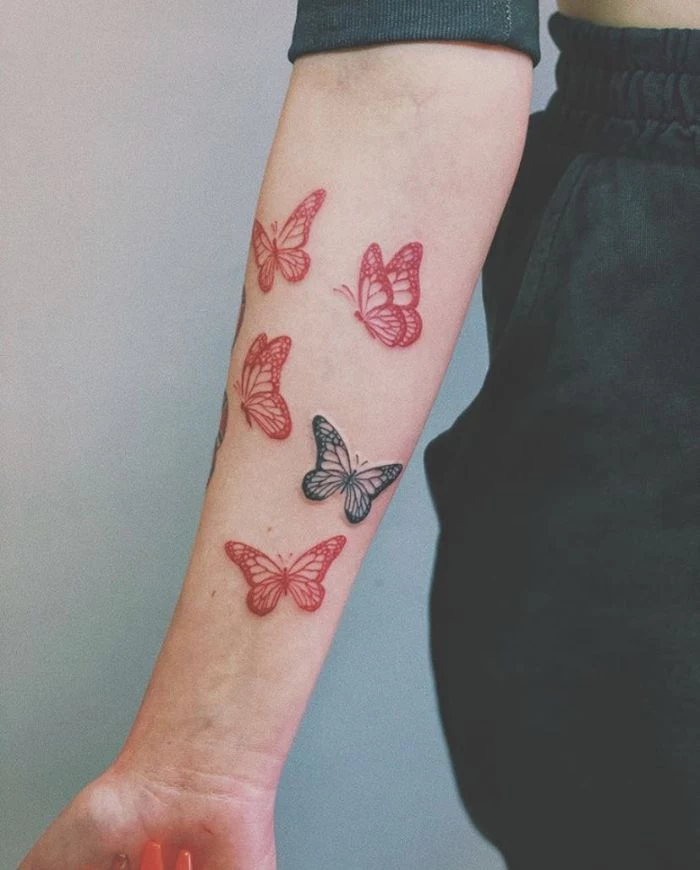
The ‘glitch’ or ‘cyber’ butterfly is a cutting-edge take on the classic. The design is intentionally distorted with pixelation, scan lines, or a 3D anaglyph effect (using red and cyan lines). It’s a statement on transformation in the digital age, blending nature with technology and reflecting a reality that’s increasingly fragmented and virtual.
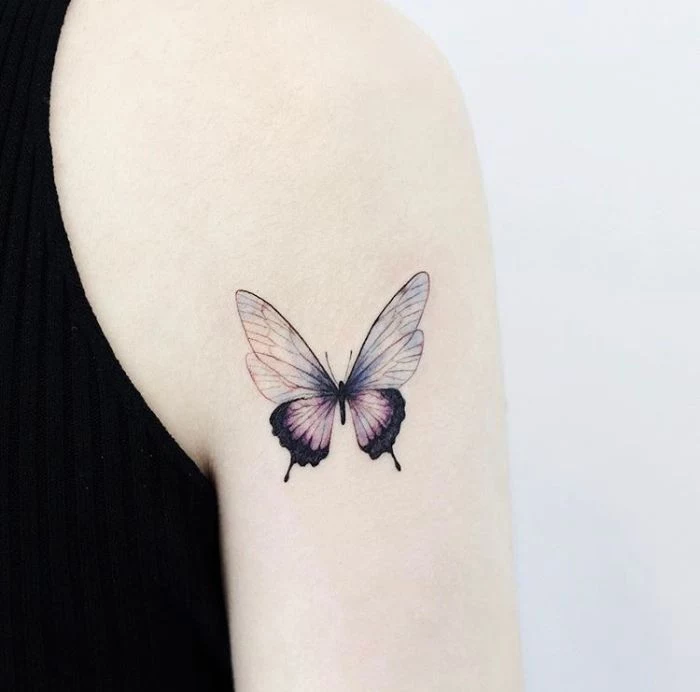
There’s no regulated ‘pain scale,’ but ask any artist and they’ll agree: bony areas with thin skin hurt most.
For a butterfly, this means the top of the foot, the ankle bone, or the center of the chest will be more intense than the fleshy outer arm or thigh. If you’re nervous about the pain, an outer bicep is a great starting point.
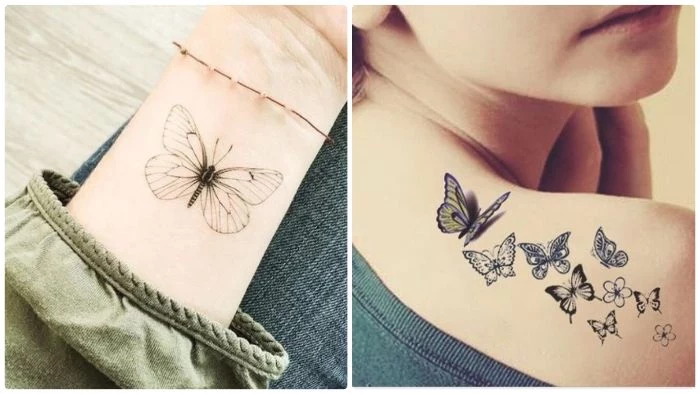
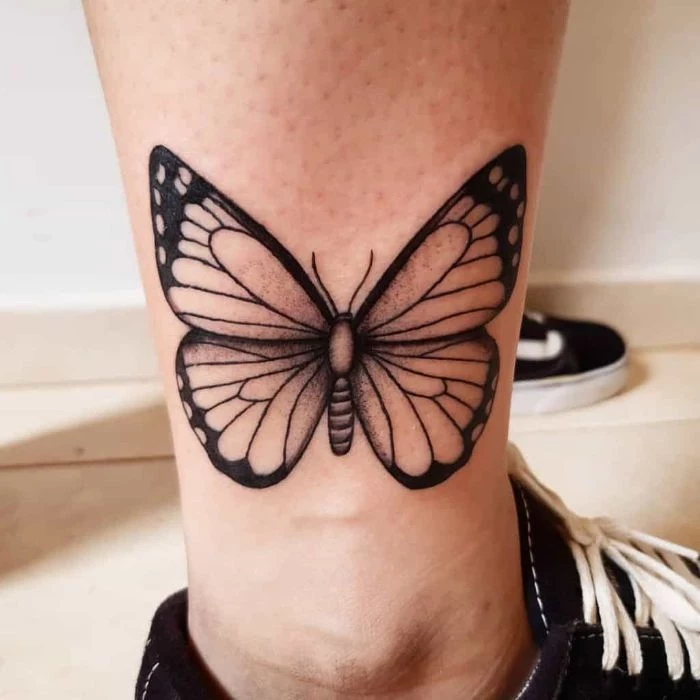
Don’t be surprised if you feel a bit rundown the day after a long tattoo session. ‘Tattoo flu’ is a real phenomenon where your body reacts to the stress and immune response of being tattooed. Symptoms can include mild fever, fatigue, and chills. It’s your body’s way of saying it’s working hard to heal. Rest, hydrate, and it will pass quickly.
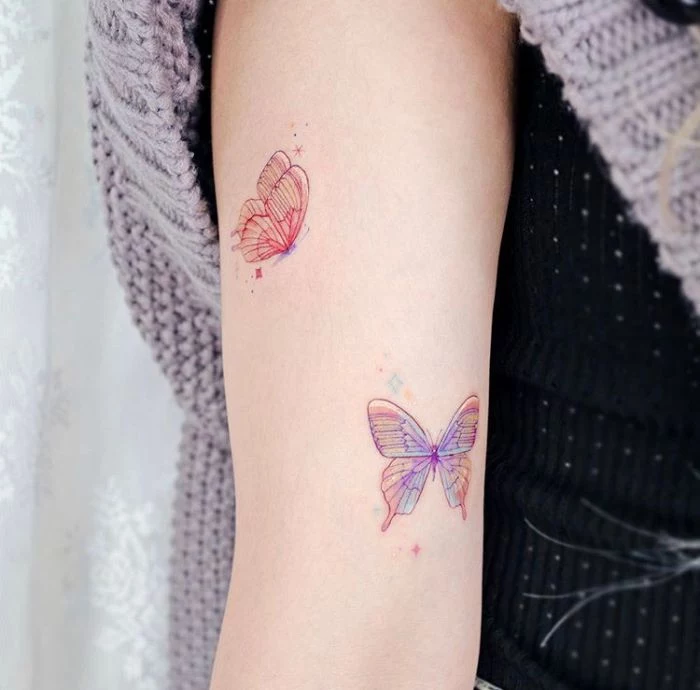
Important note on aftercare: Less is more. While it’s tempting to slather on ointment, a thick layer can clog pores and trap bacteria, hindering the healing process. Apply a very thin, barely-there layer of a recommended product like Aquaphor or a specialized tattoo balm like Hustle Butter Deluxe just two or three times a day. Your skin needs to breathe to heal properly.
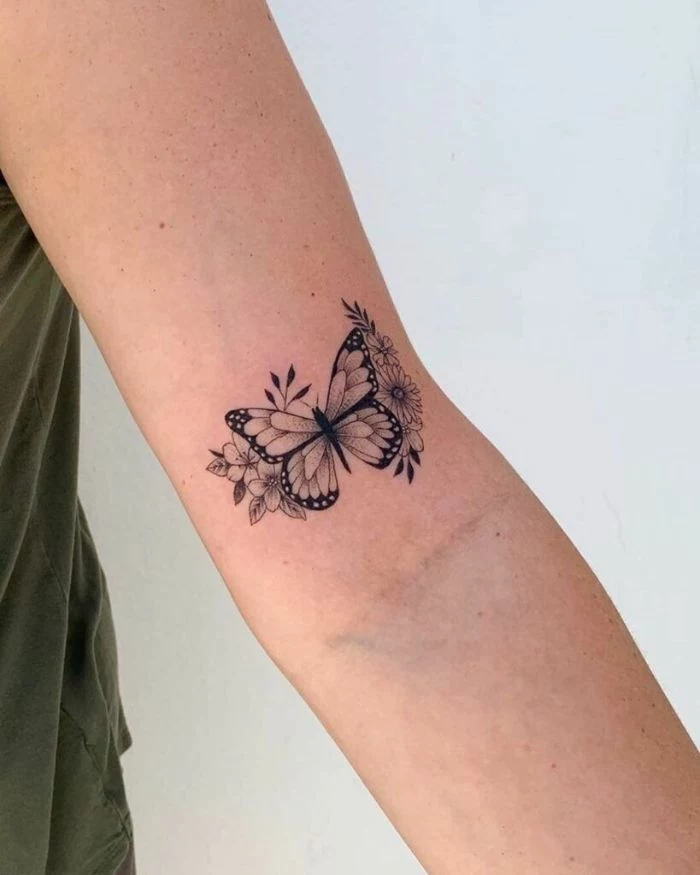
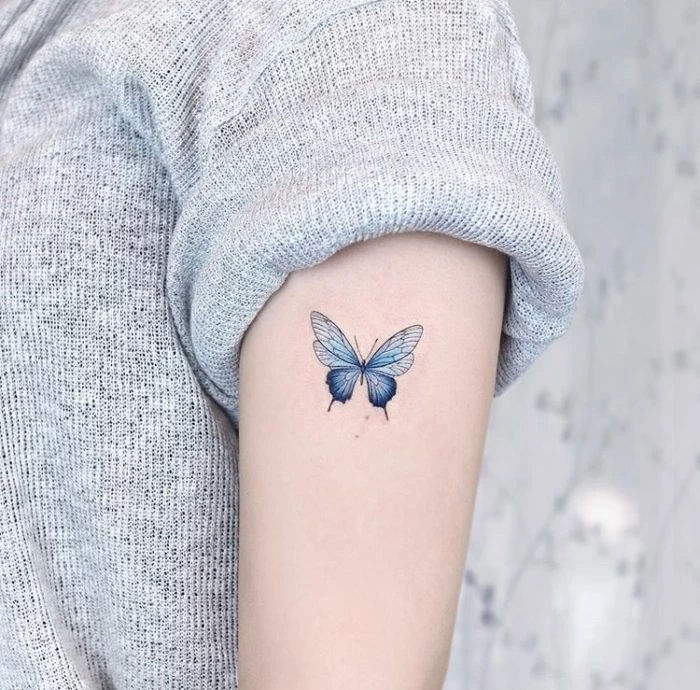
- Reference photos (of tattoos, but also real butterflies or art).
- A photo of the placement area on your own body.
- A list of key elements or feelings you want to capture.
The key to a great consultation? Be open to collaboration. You bring the ‘what’ and ‘why,’ and let your artist use their expertise for the ‘how’ and ‘where’.
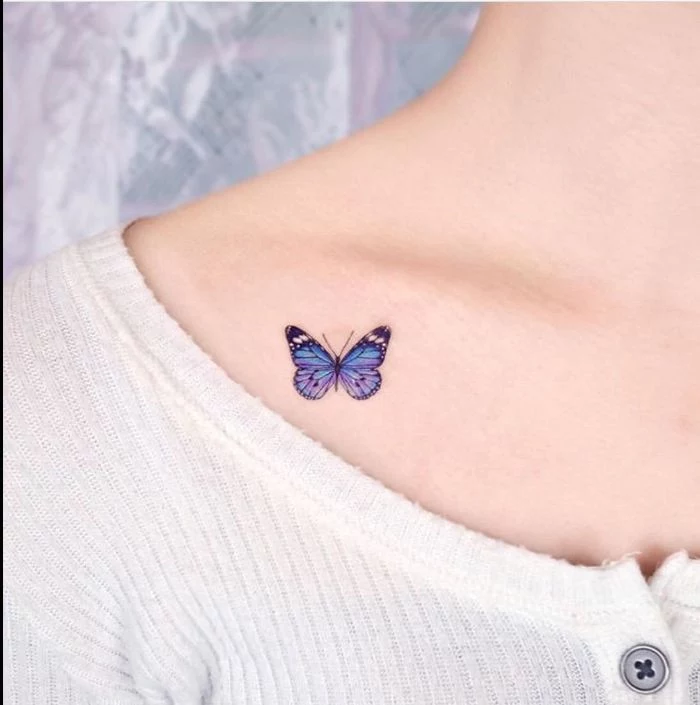
The idea of a single butterfly is classic, but a pair or a trio can add deeper meaning. Two butterflies fluttering together often symbolizes love, partnership, or reunion—making it a subtle and beautiful couple’s tattoo. A group of three can represent family, friendship, or the past, present, and future stages of your life’s journey.
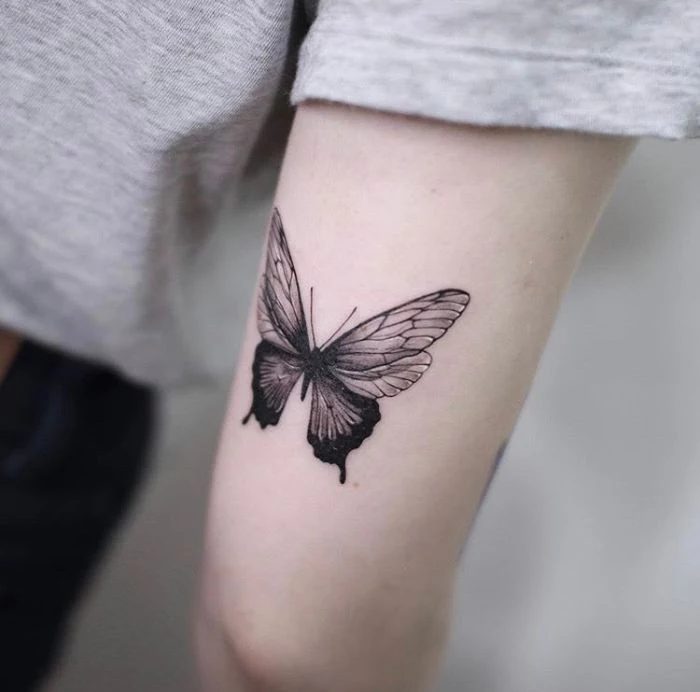

Fine-Line Style: Uses a single, tiny needle to create delicate, thin lines. Perfect for small, discreet butterflies, often on the wrist or behind the ear. It’s subtle and elegant.
Blackwork Style: Uses dense, solid black ink to create bold, graphic shapes. A blackwork butterfly is a powerful statement piece, often incorporating geometric patterns or negative space.
Your choice depends on whether you want a whisper or a shout.
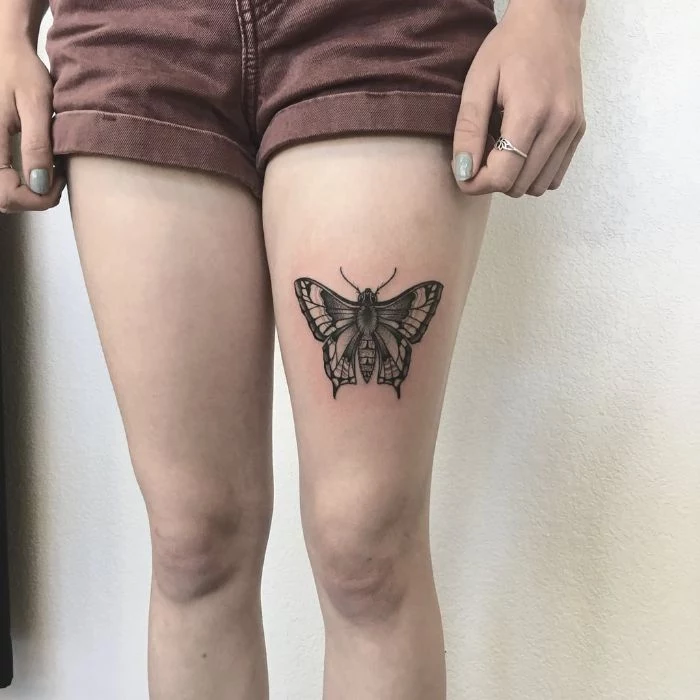
Can you get a butterfly tattooed over a scar?
Yes, and it can be a powerful way to reclaim a part of your body. However, the scar must be fully healed (usually at least 1-2 years old and no longer pink or red). Scar tissue holds ink differently, and the texture may remain. A talented artist can work the butterfly’s patterns and colors to masterfully camouflage the scar, turning a reminder of pain into a symbol of healing.
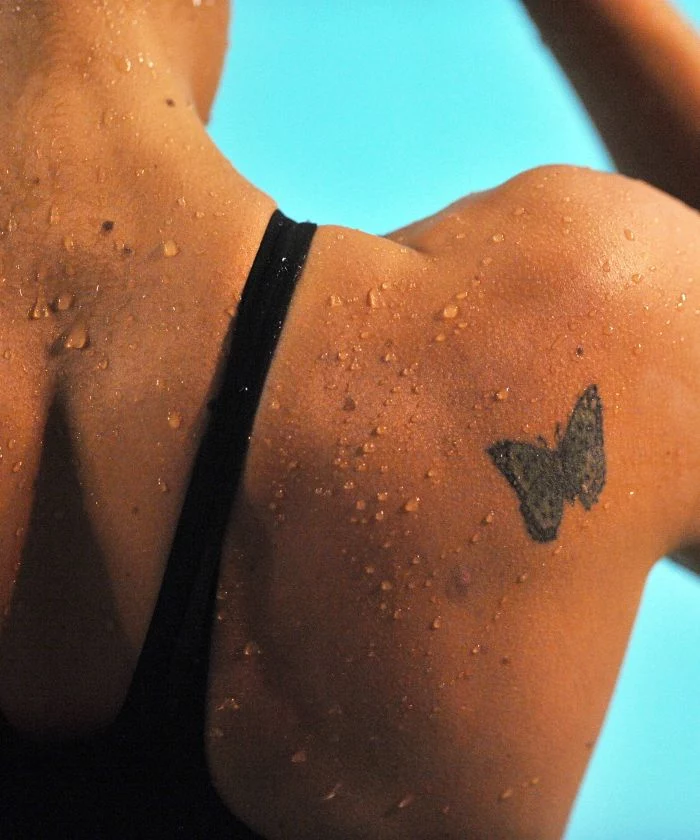
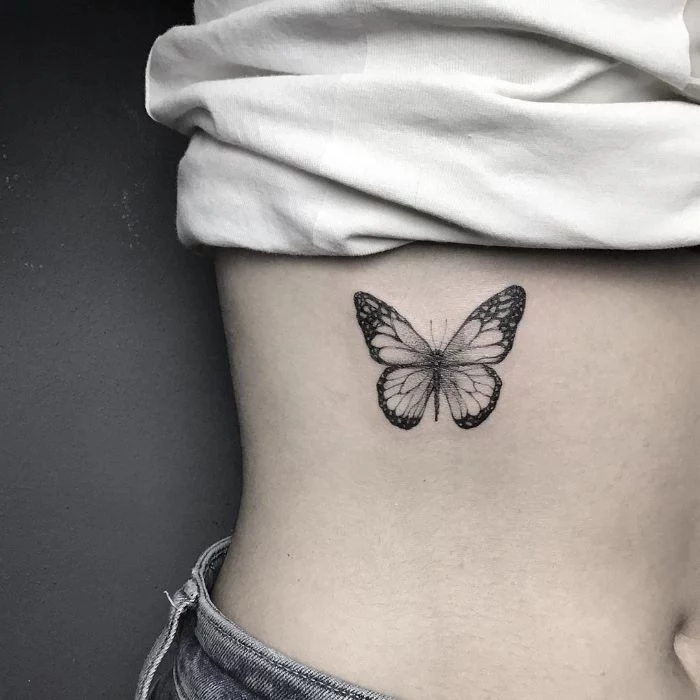
Mariah Carey’s small butterfly tattoo on her lower back became an iconic Y2K trend, but the symbol has a deeper meaning for her: it’s the emblem of her creative emancipation and her ‘Butterfly’ album.
It’s a perfect example of how a seemingly simple design can be tied to a profound personal narrative of freedom and artistic rebirth, inspiring countless fans along the way.
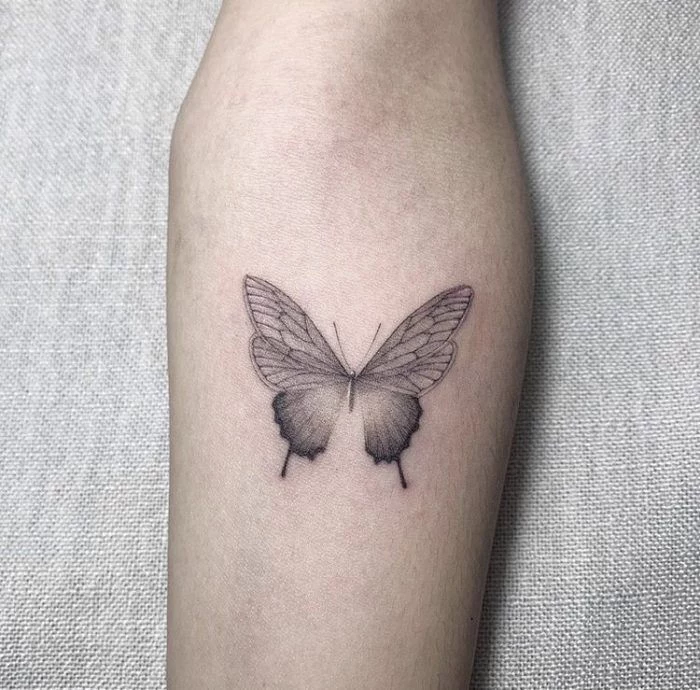
Worried about the commitment? Test drive your idea with a high-quality temporary tattoo. Brands like Inkbox offer semi-permanent ink that develops on your skin and lasts for 1-2 weeks. It’s a fantastic way to confirm you love the placement and size of your butterfly before making it permanent.
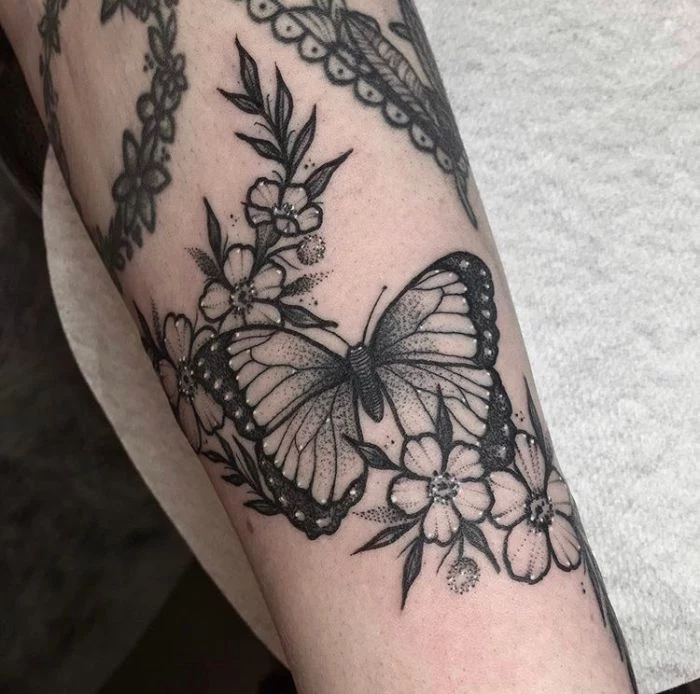
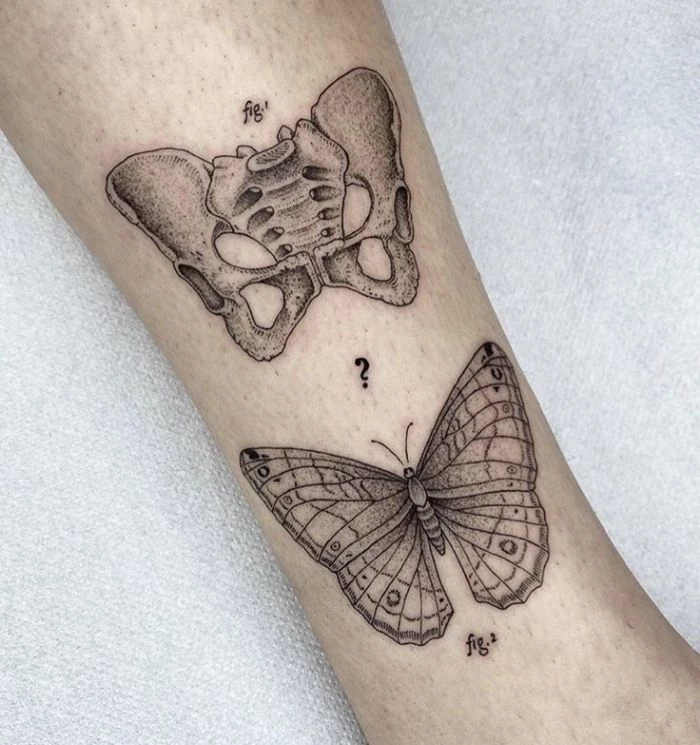
A word on cost: Don’t bargain hunt for a tattoo artist. A higher price often reflects experience, quality of materials, and artistic skill. The cost is typically based on an hourly rate or a set price per piece, and it factors in design time, sanitation, and the artist’s expertise. Investing in a great artist is investing in a piece of art you will wear for the rest of your life.
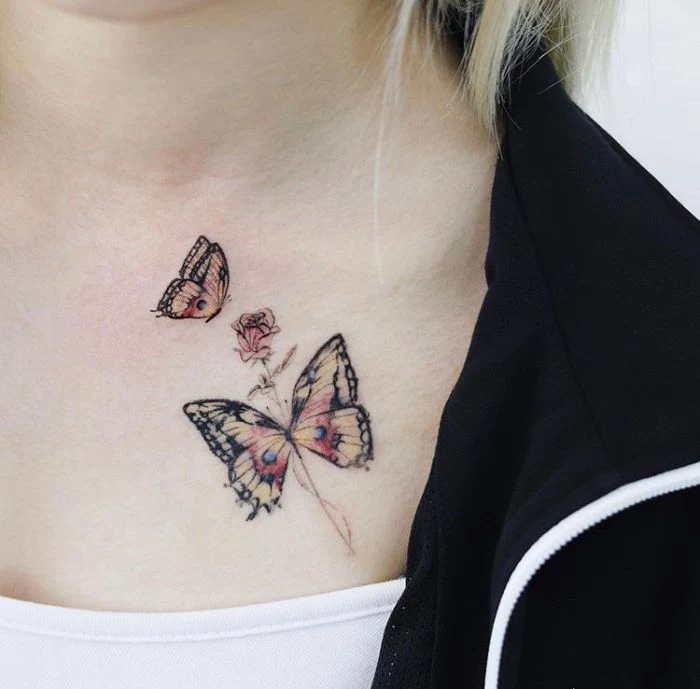
- The Monarch butterfly is famously associated with the Mexican Day of the Dead (Día de los Muertos).
- Their annual migration arrives in Mexico around this time, leading to the belief that they are the returning souls of deceased loved ones.
The takeaway? A Monarch butterfly tattoo can be a vibrant, beautiful memorial piece, celebrating the life and spirit of someone you’ve lost.
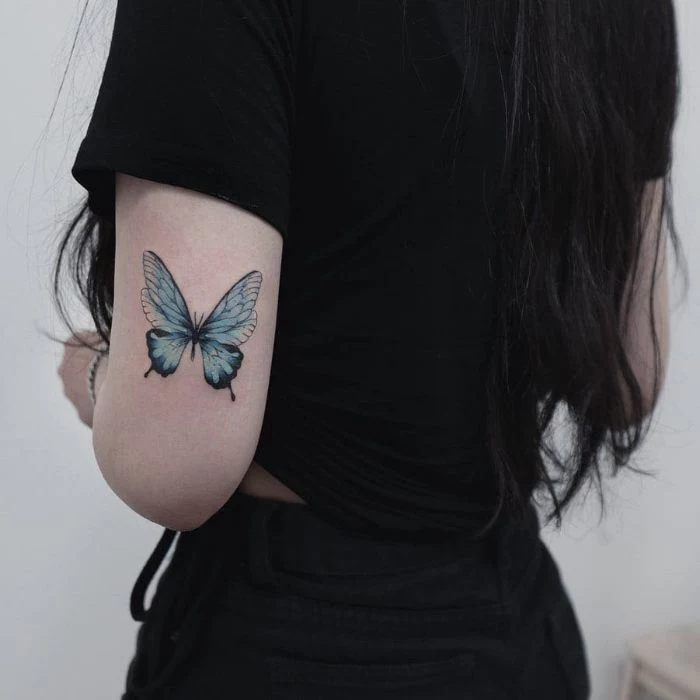
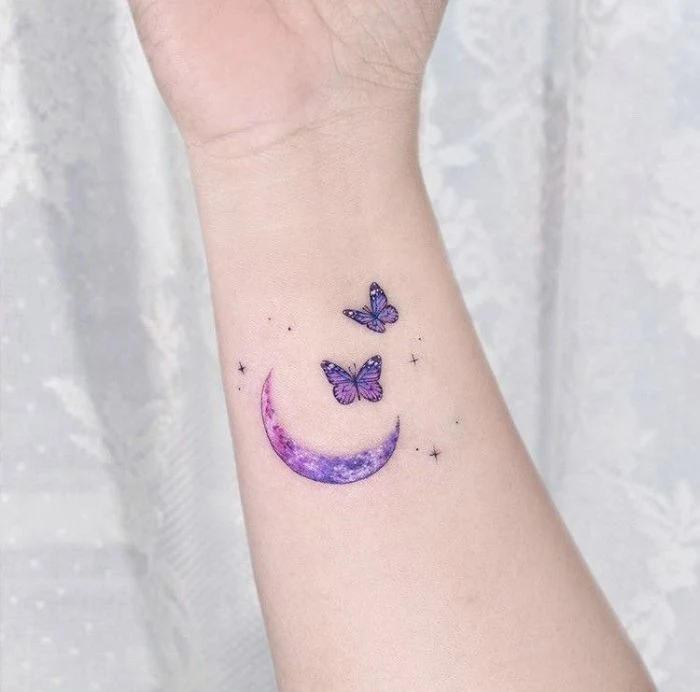
A butterfly breaking out of a chrysalis is a powerful image of transformation. But consider other creative variations to tell your story: a butterfly emerging from a keyhole to symbolize new opportunities, a butterfly with dagger wings for a fierce survivor, or a butterfly caught in a spiderweb, representing a struggle you’ve overcome.
The ‘torn skin’ effect is a dramatic 3D technique where the artist tattoos a design that looks like your skin is ripping away to reveal a cluster of butterflies underneath. It’s a visually stunning metaphor, suggesting that beauty and freedom are just below the surface, waiting to break free.

